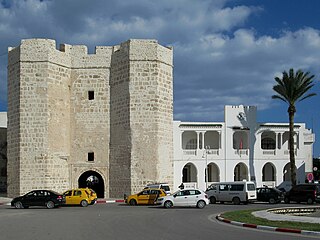Related Research Articles

Mahdia is a Tunisian coastal city with 62,189 inhabitants, south of Monastir and southeast of Sousse.

Byzacena was a Late Roman province in the central part of Roman North Africa, which is now roughly Tunisia, split off from Africa Proconsularis.
Usilla or Usula was a town in the Roman province of Byzacena, now Inchilla in Tunisia.

Thelepte was a city in the Roman province of Byzacena, now in western Tunisia. It is located near the border with Algeria about 5 km north from the modern town of Fériana and 30 km south-west of the provincial capital Kasserine.
Macri, or perhaps Macras, was a town and bishopric in the Roman province of Mauretania Sitifensis. It corresponds to the modern town of Magra, Algeria.

Assuras, sometimes given as Assura or Assur, was a town in the Roman province of Proconsular Africa.
Obba was an Ancient town in Roman North Africa. It is now a Latin Catholic titular see.

Abitinae was a town in the Roman province of Africa Proconsularis and is famed for the Martyrs of Abitinae.
Thagora was a Carthaginian and Roman town at what is now Taoura, Algeria.

Girus Tarasii was a town in the Roman province of Numidia that became a residential episcopal see. It is tentatively identified with ruins situated at what is now called Henchir-Tarsa in Algeria.
Azura was an ancient civitas and bishopric in Roman North Africa– It remains only as Latin Catholic titular see.

Aggar was a town and bishopric in the Roman province of Byzacena. One of two cities in the area, it left vast ruins that are now called (Henchir) Sidi Amara. These edifices are situated in the plain of Siliana, around 60 kilometres east of Maktar.

Tagarata, was a Roman era civitas of the Roman province of Africa Proconsularis. The ancient town has been tentatively identified with ruins either at Tell El-Caid, one of three tell at Aïn-Tlit or Henchir Kahloulta in the region of Carthage, Tunisia. The ancient town is known to history as the home of the Donatist Bishop Donato, who intervened at the Council of Carthage (411), it seems that time the town had no Catholic bishop. The bishopric exists today only as a titular see of the Roman Catholic Church.

Ksour-El-Khaoua is a locality in southern Tunisia, North Africa. During the Roman Empire the town was a civitas (town) in the Roman province of Byzacena. and the seat of an ancient Christian bishopric.
Cilibia was an Ancient city and bishopric in Roman North Africa, which remains a Latin Catholic titular see.

Giru Mons is an ancient town of the Roman Empire and a titular bishopric of the Roman Catholic Church. The ancient town has been tentatively identified with ruins at Yerroum, northern Algeria.

Sufasar was a Roman town, one of many in Roman North Africa. Sufasar faded with the Muslim conquest of the Maghreb. The site has been tentatively identified with ruins at Amourah in modern Algeria.

Tamada was an ancient Roman–Berber civitas in the province of Mauretania Caesariensis. The town lasted through the Byzantine Empire, Vandal Kingdom and Roman Empire into late antiquity, until at least the Muslim conquest of the Maghreb in the 7th century.

Mididi was a Carthaginian and Roman settlement during antiquity, located at what is now Henchir-Medded, Tunisia. 14 neo-punic inscriptions, known as the Mididi inscriptions, were found in Mididi by René Basset.

Præsidium also known as Praesidium Diolele was a town of the Roman Province of Byzacena in North Africa during the Roman Empire.
References
- ↑ Macbean, A. (1773). A Dictionary of Ancient Geography: Explaining the Local Appellations in Sacred, Grecian, and Roman History. London: G. Robinson. p. 14. OCLC 6478604.
- 1 2 3 4 5 J. Mesnage, L'Afrique chrétienne, (Paris, 1912), pp. 140–141
- ↑ Image of section of the Tabula Peutingeriana with Ruspe
- ↑ Henricus de Noris in Migne's Supplement to the Works of Augustine, Patrologia Latina, vol. 47, col. 297B
- ↑ Book IV, Chapter 3
- ↑ Alexander MacBean, Samuel Johnson, A Dictionary of Ancient Geography (G. Robinson, 1773)
- 1 2 William Smith, Dictionary of Greek and Roman Geography (1854)
- 1 2 Stefano Antonio Morcelli, Africa christiana, Volume I, (Brescia, 1816), pp. 265–266
- 1 2 Annuario Pontificio 2013 (Libreria Editrice Vaticana 2013 ISBN 978-88-209-9070-1), p. 961
- 1 2 3 4 5 G. Ch. Picard, "Ruspe" in Enciclopedia dell'Arte Antica (Treccani 1965)
- ↑ Edward Gibbon, The History of the Decline and Fall of the Roman Empire, 5 (Baudry's European Library, 1840), chapter 41, footnote 15
- 1 2 3 Sophrone Pétridès, "Ruspe" in Catholic Encyclopedia (New York 1912)
- ↑ The Princeton Encyclopedia of Classical Sites (1976)
- ↑ Henchir Bou Tria: Tunisia
- ↑ Rass Bou Tria
- ↑ Pius Bonifacius Gams, Series episcoporum Ecclesiae Catholicae, (Leipzig, 1931), p. 468.
- ↑ La sede titolare nel sito di www.catholic-hierarchy.org
- ↑ La sede titolare nel sito di www.gcatholic.org